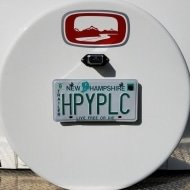Leaderboard
Popular Content
Showing content with the highest reputation on 07/20/2018 in all areas
-
So you've got 320 watts of solar panels, but what does that really mean out in the real world? Let's find out. Say you're headed to Sedona in October. Like me, you like to punish your trailer by taking it down long washboard gravel roads in the middle nowhere, so you've picked out a nice spot in the Red Rock Wilderness to set up camp for a few days. You don't want to take a generator, and none of the rocks have outlets, but you'd like to keep your batteries topped up. So in order to know how far down you can take your batteries, you need to know what to reasonably expect out of your solar panels. Here's how you do it - Step 1 - go to this website: US Solar Radiation Resource Maps Step 2 - Select the following options: Data Type = Average; Month = October; Instrument Type = Horizontal Flat Plate Step 3 - Click "View the Map" You'll be presented with a map that looks remarkably like this: Step 4 - Locate Sedona and read the key to find the average daily solar radiation for a flat panel in that location in October. About 4.5 kWh or so. Step 5 - Do some easy math. Take the number from the chart (4.5) then multiply it by the wattage of your panels (320). That gives you the Watt Hours that you can expect from your panels. Well, not really. That's under ideal conditions without accounting for dusty panels, wiring and charger losses, etc. Most people assume a 30% loss for that stuff, so to make your number real you need to multiply it by 0.7. Then to convert Watt Hours into Amp Hours, which is all we care about, divide your answer by 12 volts (volts x amps = watts). So, 4.5 x 320 x 0.7 ÷ 12 = 84 amp hours And if you have 400 Ah of battery capacity, that's 21%, so you now know that for your time there you can run your batteries down to around 80% and still reasonably expect to recoup that the next day. Of course, that's a monthly average. On a sunny day you'll get more and on a rainy day you'll get much less. And if you found a tree out there and parked under it you'll get even less. But for planning purposes, that's a pretty good number to work with and if you plan to be there a week then you'll probably be close to that, on average. Arguably, you could use the "maximum" numbers, rather than average, since that will be closer to what you'd expect on a sunny day, so it might be worth taking a look at that as well. It really depends on if you'd expect rain or clouds where you're going. In general I've found that the average values are pretty close to what we've seen, but as time goes on I'll know better and maybe will be able to adjust the fudge factor for our system. If you have a portable panel that you like to put out, then go through the same process, but choose "Flat Plate Tilted at Latitude" instead of "Horizontal Flat Plate", assuming that you're not just going to lay your panels flat on the ground. I made a little chart that I put in the notes on my phone that has the expected amp hours for the general areas we like to visit in the month we travel, which is usually May and October for us. It's a nice little reference for us to know that we aren't overdoing the power usage.7 points
-
Thanks, Overland. When tne installer did a preliminary study on our home, he laid out the panels for best sun, averaging season. We are still zero electric bill on the house, with surplus, four years later. We undersized the system, but apparently kept everything quite efficient in operations. But, our house doesnt move. We find travel camping, with reasonable sun, we are fully charged any day on the road. 200 watts of 10 year old panels, 210 amp hours of storage. We have our problems when we stay put. In the shade... Our recent addition of a portable 100 watt panel makes a huge difference.enjoy the cool shade in the trailer. Move the panel. Also easier to adjust the angle of the portable panels, than climbing up to adjust our trailer mounted panels. Btw, do you have 400 ah storage in your lithium batteries. Im jealous..... Sherry2 points
-
Were John and Susan from Ft. Worth, Texas and plan to take the tour this Fall and plan for our next trailer. We will be coming from a Casita to the Oliver, wow, what a difference that will be. Glad to be on this forum and have a lot of reading and question to do, just part of the buying process for me, wife says, just do it. Thanks, Trainman1 point
-
We've found that our Cradlepoint system gets better reception than our phones. I'm sure that's partly due to the antenna being on the roof and partly due to it just being a better antenna in general. It doesn't do anything to help our phone reception of course, but often we'll have internet even when our phones can't find a tower. What I like, and wish we could justify taking advantage of, is that the router will accept two sims from different services. So if we wanted to pay for it, we could get an unlimited plan from Verizon to add to our AT&T plan and that would increase our coverage dramatically, especially out west. I've considered adding a WeBoost, since we could put the internal antenna right next to the router and get an even better signal. Maybe in the future. I've also considered just putting the Cradlepoint antenna on a mast to see what it would do.1 point
-
Sometime in the last few months, we started receiving the new Chevy magazine, "New Roads." In issue 11, there is a great interview with a former head of truck engineering, now aged 101, entitled "Truck Tales." Mary Barra, the new ceo, phones in with a few questions. For those of us who drove Chevys in the sixties and seventies, its fun and nostalgic.... Interview with former truck engineer There's also a good basic article on towing, "Trailering 101." I see that Chevy now supports a rearview trailer camera on its own screen... Nice. Do other manufacturers offer that option? Haven't looked lately.... Sherry1 point
-
Yeah, I have in my little chart what we’d add with a portable panel. It’s surprising what a small panel can produce since it’s tilted. Especially in winter tilting the panels makes a huge difference. We do have 400Ah which equates to about 360 useable. With our extra solar, electricity is the one thing we never run out of. I wish I could do the same with water and propane.1 point
-
Most camping world facilities are dometic service centers. Call the closest one and check. We had good experiences with camping world new port richey on our old dometic fridge. they handled everything under warranty, with no cost to us. A capacitor is easy and quick. Hope, for you, thats all it is. Sherry1 point
-
1 point
-
Recent Achievements









